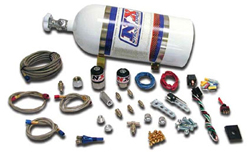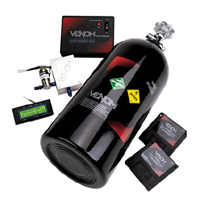Buyer's Guide for Nitrous Oxide Systems: Get a whiff of this!
 |
| Nitrous Oxide Kit |
So, how does it work?
Like all performance enhancements, nitrous makes your engine more efficient. In other words, it makes better use of every cycle of the crankshaft. Let's see how this works. Nitrous makes big power by adding a lot more oxygen to the air/fuel mixture that is injected into your cylinders naturally. In fact, nitrous gas contains about 2.3 times as much oxygen per cubic foot than air does. More available oxygen means that more fuel can be injected, and more fuel means more power. But that's not all nitrous does. Because nitrous is stored in liquid form in a bottle at high pressure, it cools significantly as it expands. Remember high school physics? Gases condense when they cool down, so besides adding a lot more oxygen into the air/fuel mixture, Nitrous also helps cool the intake charge, thereby topping out the raw oxygen level in your engine's cylinders.
But wait-it gets even better.
The most important power-producing property of nitrous is that it expands in the combustion chamber-at 565ºF, to be exact. So as the piston is compressing the (already highly enriched) air/fuel mixture, the nitrous expands at the same time. All this makes for an explosion that will BLOW YOUR MIND (but hopefully not your heads).
 |
| Some nitrous kits are programmable via PC. |
Convinced? Let's get down to da nutz and boltz. Nitrous kits come in three varieties: dry kits, wet kits, and direct port kits.
A dry nitrous kit has a single outlet nozzle that sprays a mist of nitrous gas into your air intake tube. The nozzle is controlled by a dedicated solenoid but relies on your MAP sensor and ECU to adjust the fuel level. Unless, of course, you have an air/fuel controller like the APEXi SAFC-II. This setup is simple and relatively easy to install, but can cause detonation problems. Detonation is the premature combustion of gasoline because of excessive temperature in the combustion chamber (Ha! Put that on your list of things not to do prematurely!). This is usually caused by a lean air/fuel ratio. If there isn't enough fuel in the combustion chamber to match the oxygen, it will burn with too much heat. This can screw you in ways you wouldn't see even in the hottest Jenna Jameson flick. You can prevent detonation by monitoring your air/fuel ratio gauge and your exhaust gas temperature (EGT) gauge. If your air/fuel ratio is low and your EGT is high, you've got yourself a problem.
A wet nitrous kit, on the other hand, uses a dual outlet nozzle that sprays both nitrous and fuel into your intake manifold. In the typical wet kit, dedicated solenoids control the air/nitrous/fuel mixture, so there's less risk of premature combustion.
Wet and dry kits are relatively cheap and give you a lot of bang for the buck. The only drawback (and it's a minor one) is the fact that they use a single nozzle setup that feeds into your intake manifold. This feeds the inner cylinders slightly more than the outer cylinders.
For the ultimate in performance and control, consider a direct port kit. Direct port kits use one nozzle per cylinder to spray the nitrous/fuel mixture directly into each combustion chamber for the best possible explosion every time. As you probably guessed, direct port kits are by far the most expensive nitrous kits on the market.
So, what's the downside to nitrous? There are a couple of drawbacks. The first is that you can only use whatever nitrous you carry with you, which is usually in a bottle stored somewhere in your car. A typical 10 lb. nitrous bottle contains enough nitrous to last for about 15 squeezes if you're running a 50 shot, so if you're daydreaming of driving from New York to L.A. in a 300 MPH nitrous-induced frenzy, you can stop dreaming now. The other potential drawback is that nitrous commands R-E-S-P-E-C-T. When you run nitrous, your engine runs WAY hotter than usual, and if you don't tune it right, your engine could be reduced to four little bowls of piston soup with crispy fried valves floating on top. For this reason, I recommend that you have your nitrous kit installed by a knowledgeable technician. If you do install it yourself, be sure to set aside some extra time to read all the instructions that come with your kit.
That's all there is to nitrous oxide! It goes back to the old theory (which you'll remember if you read my article about cold air intakes) that the more air, the colder the air, the more fuel, the more...you get the picture.

